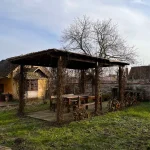October 20, 2023 – The Karanac Street of a Forgotten Time ethnographic collection by Vladimir Škroba – Baje has finally been given the recognition it deserves. As per the decision of the Ministry of Culture and Media, the collection of 847 items was listed in Croatia’s Cultural Heritage register in September this year.
Displayed in the courtyard of the Baranjska kuća restaurant in Karanac (Kolodvorska 99), writes SiB, the collection began to form in 2004 when the owner began collecting traditional objects and tools. The idea was to form a kind of open-air museum to add value to his restaurant.

Barns, traditional wooden farm buildings, a mill, and model houses were built using traditional materials such as brick, mud, and lime.
The objects date from the end of the 19th and the beginning of the 20th century, and the tools and the related craft products are displayed according to specific themes.
Karanac Street of a Forgotten Time – History and Design
One of the barns, for example, plays a barber shop from the beginning of the 20th century, another an inn. In the yard, an ice house was also built, a commercial building intended for storing ice extracted from the Danube during the winter. In addition to crafts, the exhibition includes numerous agricultural tools and machines that were part of rural farms in the first half of the 20th century.
The landscaped courtyard, named the Karanac Street of Forgotten Time, was opened in 2010, and the collection of objects kept growing. The full collection of traditional items so far contains several thousand items, of which 847 have been processed.

Examples of particularly valuable items include a collection of wooden molds for the production of traditional winter hats and a collection of ratchets and clappers whose primary function was to protect the grapes in Baranja vineyards.
The main goal when the Karanac Street of Forgotten Time was formed was to display and save all the crafts that were necessary for everyday life in the countryside, but are now completely forgotten or there are no longer masters who practice the arts.
An exceptionally rich and valuable collection of ethnographic objects is presented in an attractive way in a well-organized space. While it faithfully displays the history of crafts and traditional trade of Baranja, it is also representative of the rest of eastern Croatia. As such, it now finally reached the well-deserved status of Croatian cultural heritage.











